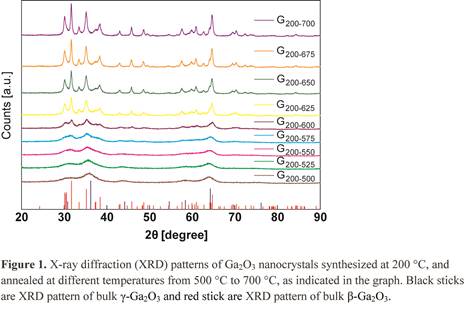Reports: ND453856-ND4: Defect-Mediated Manipulation of Excited-State Reactions at the Metal Oxide Surfaces in Solution
Pavle Radovanovic, PhD, University of Waterloo
During the second reporting period of the grant, we invested our efforts in three related directions necessary to achieve the ultimate goal of controlling the excited-state photochemical reactions using high surface area transparent metal oxides: i) expanding the means of controlling native defect formation and interactions in nanocrystalline transparent metal oxides, ii) theoretical understanding of the electronic structure and interactions of native defects, and iii) demonstration and quantitative investigation of the photocataytic activity of high surface area Ga2O3 and related metal oxides.
i) We expanded on our results from the first reporting period on controlling the defect formation and interactions in nanocrystalline Ga2O3 via incorporation of europium ions with mixed oxidation states (Eu2+ and Eu3+). Specifically, we prepared a series of Eu-doped In2O3 nanocrystals with varying size and structure. Indium oxide exists in two polymorphs with different electronic structure and properties: cubic bixbyite phase having body-centered cubic structure (bcc-In2O3, stable phase) and corundum phase having rhombohedral structure (rh-In2O3, metastable phase). Using photoluminescence signatures of the two Eu oxidation states we demonstrated a control of the interactions of dopant ions with the host lattice defect sites. The nanocrystal size and structure, and the dopant oxidation state are shown to be effective tools for controlling the native defects in In2O3 nanocrystals.
ii) We performed a combined experimental and theoretical study of the photoluminescence decay dynamics of metastable γ-Ga2O3 nanocrystals at short and long time scales for different nanocrystal sizes. We developed a comprehensive theoretical model describing the photoluminescence decay dynamics based on the donor-acceptor defect interactions, and quantitatively determined the importance of exclusion distance and spatial distribution of defects. As the most notable result in this avenue of the project we showed that the exclusion distance (minimum donor-acceptor separation in a nanocrystal) is comparable to the Bohr radius of the donor and has a stronger effect on the photoluminescence decay dynamics curve at short times than the spatial distribution of the defect sites.
iii) We examined the photocatalytic activity of nanocrystalline Ga2O3, as a key step in achieving the control of the excited-state chemical reactions. Using rhodamine 590 and methylene blue as model reactants, we demonstrated phase-dependent photocatalytic activity by showing that the photocatalytic efficiency of γ-Ga2O3 is significantly higher than that of β-Ga2O3 (Figures 1 and 2). The photocatalytic efficiency of these two nanocrystal phases is strongly correlated with the structure and concentration of native defects, suggesting their role in trapping of the photogenerated charge carriers. The results of this work indicate that nanocrystal structure and size allow for the control of the charge carrier dynamics, enabling the enhancement of the photocatalytic activity of polymorphic metal oxides.
The ACS-PRF grant has been the most important factor in the development of this project. It provided a support for several graduate students involved in different aspects of this project, and allowed them to expand on the initial ideas. This grant was also critical for me as the PI to obtain the results for other grant applications, and formulate new ideas for future projects. Importantly, this project continues to generate research output, resulting in one more publication (in addition to the publications already reported in the previous period), and two manuscripts currently in preparation.













